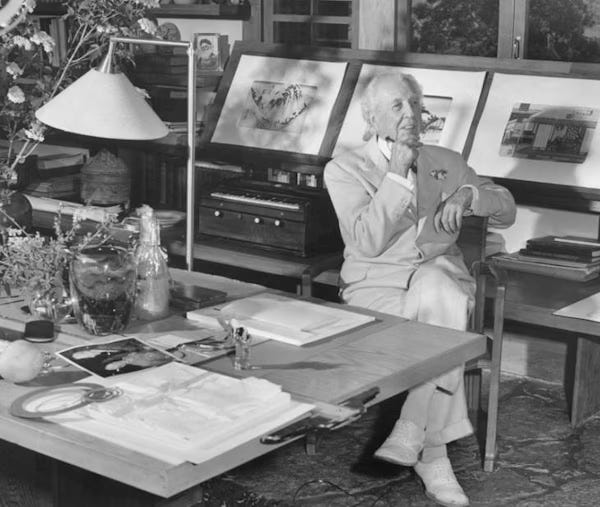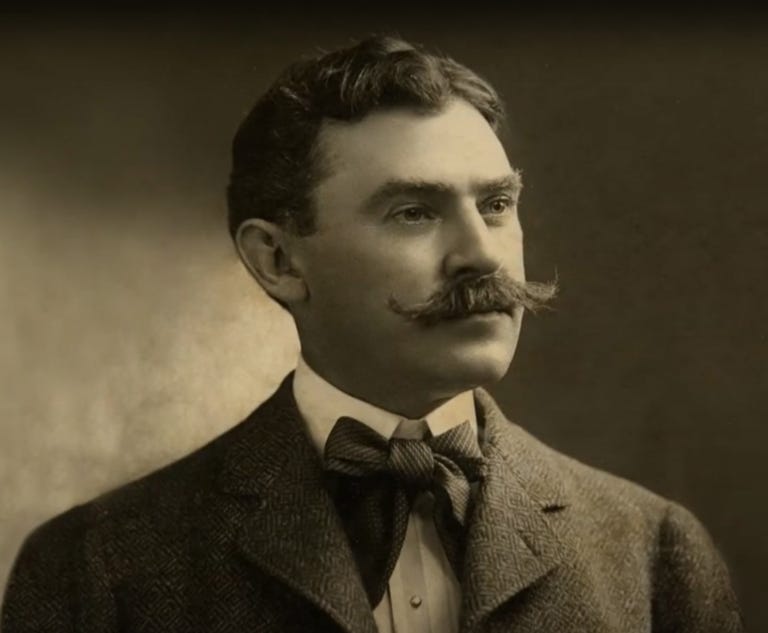Frank Lloyd Wrong Part 1
In my twenty-plus years of living in the world of Frank Lloyd Wright, I confess that I went from being an ardent devotee to a relentless critic. I know I’m not the only one. I’ve written about it before (maybe you remember this post from a few years ago), and I will most likely never stop openly scrutinizing him. Yes, I know I’m contributing to the problem (I probably should get over my ex one of these days). There is this strange obsession that takes place where all you want to do is learn and share everything you can about the man. Then, suddenly, you realize how awful he was as a person, and that the cult that exists around his myth is just too much. Like, enough already. Wright was born exactly 157 years ago today, yet it doesn’t seem like he will ever go away.
One could argue that this is exactly what Wright would have wanted. Because of his egotistical nature, Wright enjoyed getting as much attention as possible and liked being in control, whether through the sometimes exaggerated narrative of his work or the power he had over his “slaves” (as architect Harry Weese once described them) at Taliesin. This is when the cult truly started, in my opinion. Wright took all these young, impressionable people and turned them into servile groupies who were always overshadowed by him, despite having considerable talent themselves. The “groupie thing” has evolved in other forms with individuals who travel across the country (sometimes repeatedly) to see Wright’s work, regardless of whether the building is open to the public or not. I always thought someone needs to make a documentary about these people, who obsessively document structures that have already been obsessively documented for decades. They act as if he was the only architect who ever lived. I want to scream, “Stop the fanboying! There are other fish in the sea!!!”

Do not get me started on the endless amounts of writing dedicated to him (Goodreads shows there are over 400 Wright-related books). It reminds me of Wright’s Prairie School contemporaries, such as George W. Maher and William Drummond, who have not received the recognition they truly deserve. Unlike Wright, a single monograph has never been officially published on their work, which explains why their names are not very well-known outside architecture enthusiast circles. I remember meeting a couple at my workplace, and they shared with me that they had once lived in a Wright-designed home on the North Shore. Except it wasn’t an actual Wright, as they then suddenly remembered, “It was done by some guy. GW something. I think his last name started with an M. Like Manor?” My response was “You mean George W. Maher?” and that clicked in their heads. It’s a shame to discover that people who have *actually* lived in a Maher home forgot the man’s name. He was an amazing talent who should not be overshadowed by Wright. But he is just one of many who are unfortunately, as I haven’t even mentioned the names of the talented apprentices from Taliesin who have also not gotten enough attention for their own accomplishments.
But that brings me to the main point of this post. Enough has been written about Wright. If we are going to continue publishing books about him though, especially biographies, perhaps we should go in a different direction instead of the worn-out cliché of “greatest architect who ever lived.” I know some Wright groupies were not particularly fond of the last major biography dedicated to him, Paul Hendrickson’s Plagued by Fire, released almost five years ago, which I believe was the step in the right direction (no pun intended). I thought it was well-researched and went into aspects of Wright’s life that had not been fully examined before. You have to wonder if some fans just can’t handle the truth, even if some of it is conjecture, and only want to read more of the same myths and falsehoods surrounding the architect.
Hey, I’m not trying to cancel the guy (as if so-called “cancel culture” exists when plenty of privileged millionaires and billionaires like J.K. Rowling still have their free speech rights even after saying problematic things). I just wish there was a more critical and honest examination when discussing Wright, who was fortunate to have lived long enough (almost 92 years) to create his legend. Would Wright have become a somewhat forgotten figure, like Maher, if he had died in the 1910s or 20s? After all, this was a difficult time in his life, both personally and professionally. This was decades before some of his most famous work was created, such as Fallingwater and the Guggenheim Museum. There would never have been a school at Taliesin, where apprentices have played a key role in perpetuating the architect’s story.
I’ve always wanted to write a book titled “Frank Lloyd Wrong,” which would discuss all the problematic and annoying things about him. That will never happen of course. But I can start here, which I fully intend to do all summer long. I won’t be sharing anything that has not been examined before. You may agree or disagree with my opinions. Though it’s hard to deny the factual information that I plan to share regarding all the times Wright manipulated his power over people (relationships and media), embellished the truth (or simply lied), and just acted like an outright awful human. So look for multiple parts of my “Frank Lloyd Wrong” rant, coming soon!




He single-handed created the only American architecture style. Drummond et al copied him. After prairie, he mastered Usonian, which is still in vogue today. He can even lay claim to popularizing the ranch home.
Visit Unity Temple, Fallingwater, Taliesen(s), Gugenheim and Winslow House. None of the architects you mention designed anything that had a lasting impact other than as decent copies of houses Wright previously created.
I really enjoyed your "rant"--it takes nothing away from FLW's work to say his ego and self-promotion has wrongly overshadowed many other excellent Prairie-school architects.